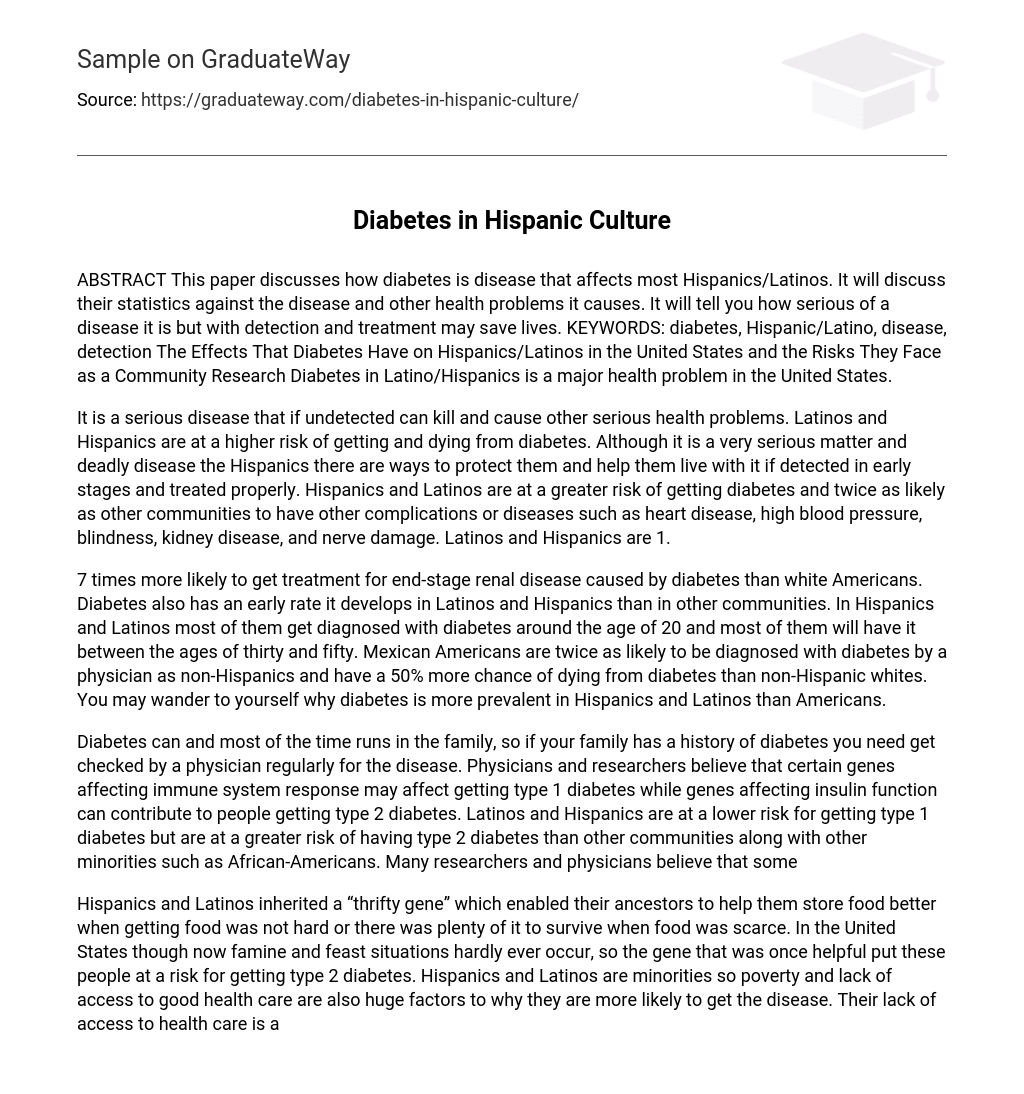Diabetes is a serious disease that can be fatal and cause other health problems if left undetected. Latinos and Hispanics are at a higher risk of developing and dying from diabetes. However, there are ways to protect them and help them live with the disease if it is detected early and treated properly. Hispanics and Latinos have a greater risk of developing diabetes, as well as being twice as likely to experience other complications such as heart disease, high blood pressure, blindness, kidney disease, and nerve damage.
Hispanics and Latinos are 7 times more likely to receive treatment for end-stage renal disease caused by diabetes than white Americans. Additionally, diabetes has a higher incidence rate in these communities compared to others. Most Hispanics and Latinos are diagnosed with diabetes around the age of 20, and many will have it between the ages of thirty and fifty. Mexican Americans are twice as likely to be diagnosed with diabetes by a physician as non-Hispanics, and they have a 50% greater chance of dying from diabetes than non-Hispanic whites. You may wonder why diabetes is more prevalent in Hispanics and Latinos than in other communities.
Diabetes can often run in families, so if your family has a history of diabetes, it is important to get checked regularly by a physician for the disease. Physicians and researchers believe that certain genes affecting immune system response may contribute to getting type 1 diabetes, while genes affecting insulin function can contribute to people getting type 2 diabetes. Latinos and Hispanics have a lower risk of getting type 1 diabetes but are at greater risk of having type 2 diabetes than other communities, along with other minorities such as African-Americans. Many researchers and physicians believe that some genetic factors may play a role in the development of both types of diabetes.
Hispanics and Latinos have inherited a thrifty gene” that enabled their ancestors to store food more efficiently when it was scarce. However, in the United States, famine and feast situations rarely occur, so this gene now puts these populations at risk for developing type 2 diabetes. Poverty and lack of access to good healthcare are also significant factors contributing to their increased likelihood of developing the disease. The lack of access to healthcare is particularly concerning as it prevents early detection and treatment.
Diabetes can be a deadly and serious disease without proper healthcare and knowledge. It is the 6th leading cause of death in the Latino and Hispanic community, with it being the 4th leading cause of death among Hispanic women and the elderly. Unfortunately, nearly one-third of Latinos do not have health insurance, which results in overall poor health since people without health insurance are less likely to have regular doctor visits or receive preventive care. Additionally, there may be language or cultural barriers that prevent Latinos from obtaining appropriate healthcare.
There are several ways to prevent diabetes. Physicians recommend drinking water whenever and wherever possible, replacing soda and other sugary drinks with water. Regular exercise is essential for maintaining good body health. Try to eat low-fat foods and use a mix of spices and herbs instead of just salt when cooking. Avoid snacking while cooking. Shopping on an empty stomach is not advisable as everything looks good; make a list before grocery shopping and only purchase the items on the list.
It is important to pay attention to food labels and avoid foods that are high in saturated fat, trans fat, sodium, and cholesterol. For snacks, consider eating a bag of popcorn or nuts as they take longer to eat than cake or pie. Experiment with different cooking methods for meat such as broiling and baking instead of frying. Additionally, try reducing your portion sizes by drinking a glass of water before each meal; this will give you the sensation of being full before you start eating, which can lead to consuming less food overall. Finally, keep track of what you eat throughout the day and do this consistently throughout the week.
Make sure you and your family are keeping regular doctor’s appointments so that if you do get diabetes, there is early detection and you can receive proper treatment right from the start. Do not let barriers hold you back from healthcare; everyone has a right to it, and there is a reason for that – everyone needs it to ensure a long, healthy life. Appropriate treatment will give you a way better chance of living longer and remaining healthy. I have talked about diabetes in Hispanic/Latino communities, its effects on many of them, and the other health concerns it may cause.
Statistics can be scary and shocking, but they are true. Early detection is key to receiving appropriate healthcare. Taking care of your body is crucial because if you don’t, no one else will. You only have one life, so make sure you maintain a healthy lifestyle to stay stronger and live longer. By doing everything necessary to maintain good health, you might be able to prevent diabetes altogether.
Diabetes may not sound like a serious disease, but it can be deadly and lead to other illnesses. In some cases, it even leads to amputation of limbs or fingers and toes.
Diabetes is a serious disease that should not be taken lightly. We can help the community by controlling diabetes and educating people about its severity. No minority group should be neglected when it comes to addressing health issues in their culture due to lack of resources or financial constraints.
Cities
- http://minorityhealth.hhs.gov/templates/content.aspx?ID=3324
- http://www.dlife.com/diabetes/type-2/diabetes-causes/hispanics
- http://www.cdc.gov/diabetes/consumer/groups.htm
- http://www.ndep.nih.gov/media/50Ways_tips.pdf?redirect=true





